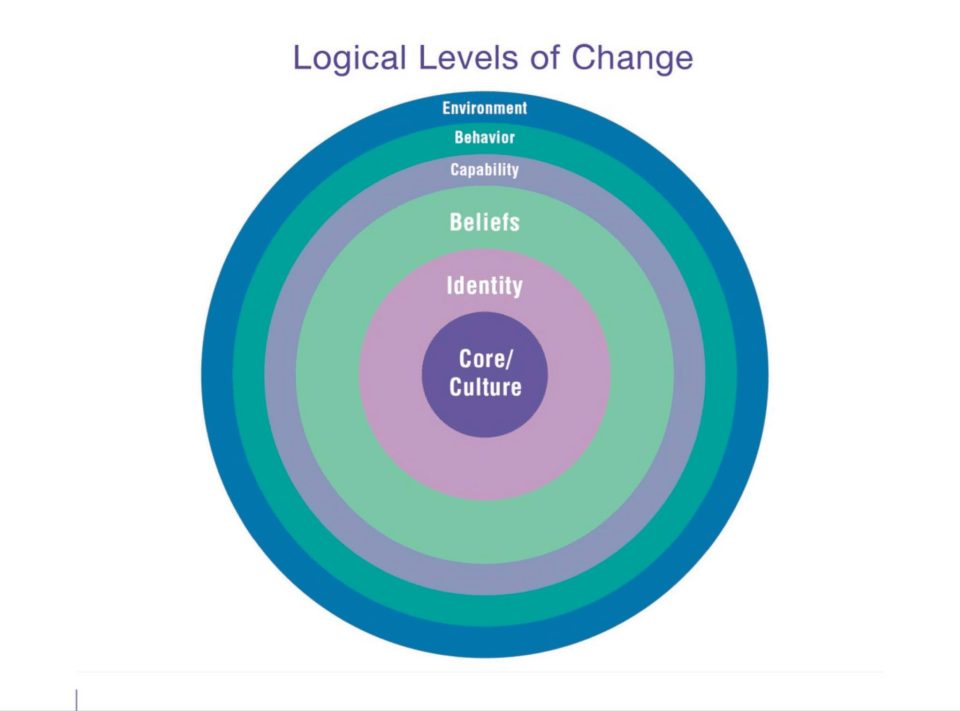In this article, I will talk about the model that Robert Dilts, one of the international trainers of NLP, created on the subject of directing change by expanding the work of anthropologist Gregory Bateson and called the Logical Levels of Change.
With this six-level model, you can discover at which level the problems in individual change or problems in communication with people are and at which levels you need to change.
And you can realize how the changes made at the levels affect other levels and how you can reach the solution faster in your life.
Here begins another powerful article that will really open your horizons!

Logical Levels:
1- Environment:
As you can see in Robert Dilts’ Pyramid of Logical Levels, the first level, “Environment”, asks “when?” and “where?” questions.
In other words, it refers to the people’s environment and external conditions. This level is the reactive dimension of people.
People at this level mostly talk about the environments and people they are in.
For example, when you take a course related to a hobby, you will get in touch with people who share the same hobby with you, you will achieve harmony and perhaps you will make a big profit thanks to this harmony.
As a result of the success you achieve at the environmental level, it will be inevitable for you to say “I would not have achieved this success if I had not been at the hobby course and met the people there.”
2- Behaviours:
The question of this level is “What?”. This level covers the people’s behaviours and thoughts at the conscious level.
Here, people think about their reaction to a situation at a conscious level and acts. In other words, what we do is for a purpose.
At this level, people talk about what they think about a situation, what they do in response to the situation, and what the consequences of their behaviour are.
3- Capabilities:
The question of this level, located on the third step, is “How?”. This level is about people’s habitual behaviours, physical skills, thinking strategies and all their capabilities.
For example, in social media and around you, you have seen or are one of the drivers who chat easily and make no mistakes while driving, cooks who cut vegetables and fruits very thin and very fast, those who do many math operations quickly in their minds, managers or experienced employees who instantly solve issues that employees have difficulty finding solutions, and so on.
At the capabilities level, there is the strategy of how to turn behaviours into skills.
4- Values and Beliefs:
One of my most important levels is the “Beliefs and Values” level, where the question is “Why?”.
This is the level where people believe in what is possible and identify what is important to them.
I’m sure there was a moment in your life when you wanted to do something – whether it was playing a musical instrument, learning a sport, learning software, being good at math, etc. – but you believed you couldn’t do it.
This is something that happens to many of us. We want to do it, but we don’t believe we can do it before we even start.
The bad news here is that you can’t do it without believing. Or even if you believe you can do it, you can’t do it if you don’t think it’s important and you say to yourself “what’s in it for me?” or “it’s not worth it”.
The beliefs and values level is the level where we become aware of all our beliefs and values, even conflicting beliefs and values.
5- Identity:
The question of this level, where we define ourselves and our mission in life, is “Who?”.
This is the level where people define who they are through their beliefs and values and determine their purpose in life.
Someone who says “I am not a smoker” has elevated not smoking to the level of “Identity” and will not easily go back to smoking.
At this level, people can recognize and positively enrich the identity characteristics they define themselves with.
Just like beliefs and values, identities can be changed and developed.
6- Purpose (Spirituality):
The question of the last level, “Spirituality”, is “What else?”.
In life, we all have, at one time or another, felt the desire to belong to something, somewhere or a greater purpose.
No matter how successful they are or no matter how much money they make, we all have seen that people who always feel that something is missing and are always searching for something, especially in these times when people’s level of importance is constantly changing and they are becoming more and more selfish.
We even see people who, even when they are successful and rich enough, commit suicide because they cannot find what they are looking for.
This level is related to this search for spirituality, the desire to belong, the harmony that people want to establish with humanity, with the universe, with God, etc.
At this level the need for self-actualization is fulfilled. Tony Robbins’ quote “The secret to liiving is giving”, which I told you in my first article is related to this level.
Knowing these logical levels will make you aware of the level of your problem and will make it faster and easier for you to find solutions.
However, an important issue that you should be aware of here is that you cannot solve problems at the level in which they occur.
Let’s give an example by reminding Einstein’s quote:
You cannot solve the insurmountable problems you face with your current mindset.
When you have problems with your co-workers or manager at work, there will be many people who will offer you solutions such as “Take a few days off and rest” or “Going on a vacation will do you good”.
However, being in the same environment after returning from leave will not solve the problems, but will cause them to grow even bigger in your mind after a while.
Because as you realize, the problem is at the “Environment” level and it is impossible to solve this problem at the same level by changing the environment.
Here, you should go to the next level, the “Behaviours” level and ask the question “What can I do?” and seek a permanent solution by changing your behavior and reactions.
If you know what to do but do not know how to do it, you should go to the next level, “Capabilities”, and ask the question “How can I do it?”.
As you can see, changing the level of the problems will make it possible to look at the problems from the outside and reach permanent solutions.
In communication there can also be level mix-ups and, as a result, problem grows and communication breakdowns.
To give an example, imagine a kid being told by kid’s parent “you are really idiot, how can you do such a thing?” when the kid makes a mistake. You are likely to see many such examples around you.
Of course, the parent who says this does not think that his/her child is idiot, but the parent has elevated his/her child’s mistake from the level of “Behaviours” to the level of “Identity”.
Even if the parent doesn’t want it, the child believes what he/she say and reflects it on his/her identity.
Especially children have a very high tendency to believe what their parents say about them.
What needs to be done here is to move from the “Behaviours” level to the “Capabilities” level and teach the child how to correct this mistake and how to do the right thing.
NLP focuses on the logical levels of “Beliefs and Values” and “Identity”.
NLP teaches us how to move faster by changing our limiting beliefs and identity.
In my articles, I will not only talk about NLP techniques, but also about the “Spirituality” level by going into different topics and determinations and I will try to help you achieve a more satisfying life for yourself.
I look forward to you contacting me on social media or my e-mail address and I look forward to learning from your life and what you do😊
Be full of energy! Believe in yourself! Live with passion!
Take care of yourself!




Leave A Reply